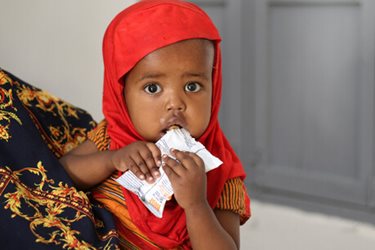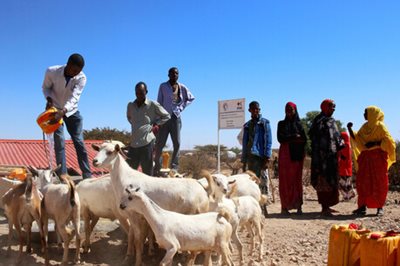By Angela Hill, Communications Delegate
Throughout the Horn of Africa, extreme ongoing drought is reshaping the lives of tens of millions as the shortage of water destroys livelihoods, causes mass migration, which explains for rising malnutrition.
“Earlier than I got here to this village I used to be a pastoralist,” stated Rama Ali Warsame, from her makeshift shelter on the sting of Hilgo. Her household, like many, moved in quest of water.
“The drought has killed our livestock …. there is no such thing as a pasture and persons are in a crucial state of affairs.”
She had a herd of greater than 70 goats, now she solely has a handful.
Wherever the Somali Purple Crescent Society (SRCS) works, they hear this story as 5 failed wet seasons over the previous two-and-a-half years has destroyed individuals’s skill to develop meals and killed off their goats, sheep, camels, and cattle. This implies households have misplaced their revenue.
Basra Ahmed Cabdale would develop tomatoes and onions, which her household would eat with sorghum and maize. They might even have milk and meat from their animals.
“Our largest fear is the lack of our animals and the shortage of meals,” she stated. “We hope we get sufficient rainfall to develop crops and feed our livestock.”
Getting water now could be troublesome.
“It takes two hours [to walk to the water point] and we have now to kind an extended queue to get it,” Basra stated.
Along with her animals dying and needing to promote surviving animals to purchase meals and different primary wants, Basra is unable to guard her livelihood sooner or later.
She introduced her two kids Muhiyadin Abdikadir, 1, and Nimco Adbikadir Hassan, 3, to be screened for malnutrition on the SRCS supported clinic close to Borama. Her daughter Nimco was discovered to be reasonably malnourished, so Basra acquired meals dietary supplements like porridge and the high-calorie Plumpy’Nut.
 She isn’t alone. Increasingly more kids should not capable of get enough diet. Moms discuss of solely having sufficient to prepare dinner rice, as soon as per day, and generally kids don’t eat in any respect.
She isn’t alone. Increasingly more kids should not capable of get enough diet. Moms discuss of solely having sufficient to prepare dinner rice, as soon as per day, and generally kids don’t eat in any respect.
There are three standards concerned in measuring famine. An space must have 20 per cent of households dealing with an excessive lack of meals and 30 per cent of kids affected by acute malnutrition. Acute malnourishment can result in kids not surviving, or even when they do survive, their progress and improvement is completely impacted. The third a part of the factors is 2 adults or 4 kids in 10,000 are every day dying of hunger.
To place this in context – if we have been speaking a few famine occurring in a metropolis with the inhabitants of Ottawa it might imply 62 kids beneath 14 years outdated dying per day, Vancouver 148 kids, in Toronto it might be 153 kids dying per day. From an absence of meals.
The state of affairs isn’t a famine but, however it’s a humanitarian disaster, which is made worse by local weather change and battle.
The important thing to supporting households is a mix of emergency response and long-term resilience constructing and planning for the long run.
The SRCS with assist from Purple Cross, Purple Crescent companions, together with Canadian Purple Cross with because of funds from the Authorities of Canada and donors are doing precisely that; making certain cash is moving into the fingers of households and dealing with communities to minimize the impacts of local weather change.
 Emergency money transfers via cellular cash, means individuals, like Koos Ahmed Mahmoud, are capable of purchase meals for his or her kids and feed for his or her animals. This enables her to hold on to her livelihood, easing restoration when the rain lastly begins once more.
Emergency money transfers via cellular cash, means individuals, like Koos Ahmed Mahmoud, are capable of purchase meals for his or her kids and feed for his or her animals. This enables her to hold on to her livelihood, easing restoration when the rain lastly begins once more.
“This assist has modified us. Earlier than there weren’t any methods to get issues that we’d like,” she stated. “I coated the wants of my kids with meals and different issues together with water, rice, sugar, milk, pasta, and greens.”
By working with communities to get roofs on group water factors, referred to as berkeds, SRCS helps local weather change resilience.
“Our largest fear is locally is water,” group member Khadra Abdi Suldan, stated. “The largest problem sooner or later is water.”
Conventional berkeds have been open to permit filling by rain and entry for animals. The rehabilitated berkeds have roofs that stop evaporation, and programs to collect the rainwater when it does rain. Within the meantime, the group brings in water by truck, an funding that’s now protected due to the roof.
“We’re thanking SRCS, as a result of they’ve rehabilitated and coated the berked,” she stated.
Throughout the Horn of Africa, extreme ongoing drought is reshaping the lives of tens of millions as the shortage of water destroys livelihoods, causes mass migration, which explains for rising malnutrition.
“Earlier than I got here to this village I used to be a pastoralist,” stated Rama Ali Warsame, from her makeshift shelter on the sting of Hilgo. Her household, like many, moved in quest of water.
“The drought has killed our livestock …. there is no such thing as a pasture and persons are in a crucial state of affairs.”
She had a herd of greater than 70 goats, now she solely has a handful.
Wherever the Somali Purple Crescent Society (SRCS) works, they hear this story as 5 failed wet seasons over the previous two-and-a-half years has destroyed individuals’s skill to develop meals and killed off their goats, sheep, camels, and cattle. This implies households have misplaced their revenue.
Basra Ahmed Cabdale would develop tomatoes and onions, which her household would eat with sorghum and maize. They might even have milk and meat from their animals.
“Our largest fear is the lack of our animals and the shortage of meals,” she stated. “We hope we get sufficient rainfall to develop crops and feed our livestock.”
Getting water now could be troublesome.
“It takes two hours [to walk to the water point] and we have now to kind an extended queue to get it,” Basra stated.
Along with her animals dying and needing to promote surviving animals to purchase meals and different primary wants, Basra is unable to guard her livelihood sooner or later.
She introduced her two kids Muhiyadin Abdikadir, 1, and Nimco Adbikadir Hassan, 3, to be screened for malnutrition on the SRCS supported clinic close to Borama. Her daughter Nimco was discovered to be reasonably malnourished, so Basra acquired meals dietary supplements like porridge and the high-calorie Plumpy’Nut.
 She isn’t alone. Increasingly more kids should not capable of get enough diet. Moms discuss of solely having sufficient to prepare dinner rice, as soon as per day, and generally kids don’t eat in any respect.
She isn’t alone. Increasingly more kids should not capable of get enough diet. Moms discuss of solely having sufficient to prepare dinner rice, as soon as per day, and generally kids don’t eat in any respect.There are three standards concerned in measuring famine. An space must have 20 per cent of households dealing with an excessive lack of meals and 30 per cent of kids affected by acute malnutrition. Acute malnourishment can result in kids not surviving, or even when they do survive, their progress and improvement is completely impacted. The third a part of the factors is 2 adults or 4 kids in 10,000 are every day dying of hunger.
To place this in context – if we have been speaking a few famine occurring in a metropolis with the inhabitants of Ottawa it might imply 62 kids beneath 14 years outdated dying per day, Vancouver 148 kids, in Toronto it might be 153 kids dying per day. From an absence of meals.
The state of affairs isn’t a famine but, however it’s a humanitarian disaster, which is made worse by local weather change and battle.
The important thing to supporting households is a mix of emergency response and long-term resilience constructing and planning for the long run.
The SRCS with assist from Purple Cross, Purple Crescent companions, together with Canadian Purple Cross with because of funds from the Authorities of Canada and donors are doing precisely that; making certain cash is moving into the fingers of households and dealing with communities to minimize the impacts of local weather change.
 Emergency money transfers via cellular cash, means individuals, like Koos Ahmed Mahmoud, are capable of purchase meals for his or her kids and feed for his or her animals. This enables her to hold on to her livelihood, easing restoration when the rain lastly begins once more.
Emergency money transfers via cellular cash, means individuals, like Koos Ahmed Mahmoud, are capable of purchase meals for his or her kids and feed for his or her animals. This enables her to hold on to her livelihood, easing restoration when the rain lastly begins once more.“This assist has modified us. Earlier than there weren’t any methods to get issues that we’d like,” she stated. “I coated the wants of my kids with meals and different issues together with water, rice, sugar, milk, pasta, and greens.”
By working with communities to get roofs on group water factors, referred to as berkeds, SRCS helps local weather change resilience.
“Our largest fear is locally is water,” group member Khadra Abdi Suldan, stated. “The largest problem sooner or later is water.”
Conventional berkeds have been open to permit filling by rain and entry for animals. The rehabilitated berkeds have roofs that stop evaporation, and programs to collect the rainwater when it does rain. Within the meantime, the group brings in water by truck, an funding that’s now protected due to the roof.
“We’re thanking SRCS, as a result of they’ve rehabilitated and coated the berked,” she stated.


